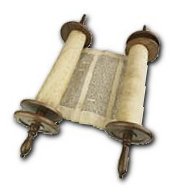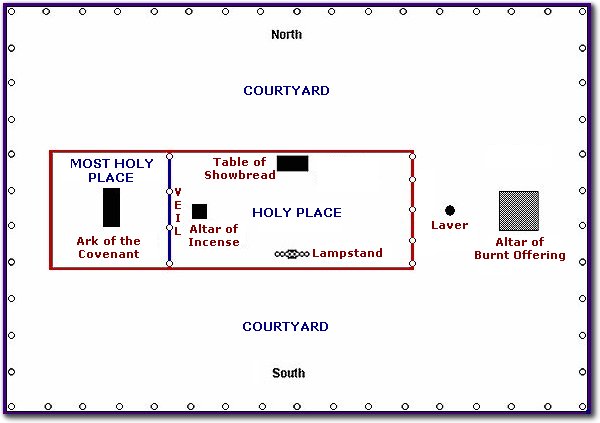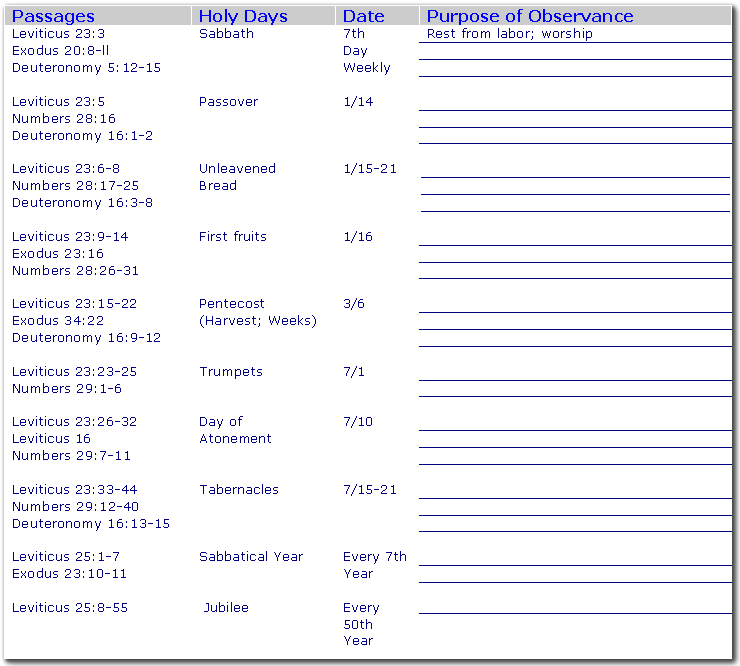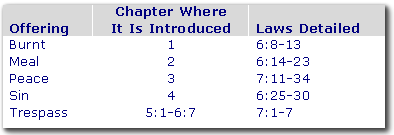|
In this Section:
The Book of Genesis | The Book of Exodus | The Book of Leviticus
The Book of Numbers | The Book of Deuteronomy
Introduction
 In the previous lessons, you learned... In the previous lessons, you learned...
- that the Bible is the written Word of God;
- it is divided into two major sections called the Old Testament and the New Testament;
- the four divisions of the Old Testament books are Law, History, Poetry, and Prophecy;
- the four divisions of the New Testament books are Gospels, History, Letters, and Prophecy; and
- the different methods of studying the Scriptures.
With this lesson you begin a basic survey of the books that make up the major divisions of the Old Testament.
It is generally believed that Moses wrote the books of Law, which span a period of about 600 years. The books of Law consist of five books:
- Genesis
The first book in the Bible, Genesis, records the beginning of creation, man, the Sabbath, marriage, sin, sacrifice, nations, and government. It also records the stories of key patriarchs Abraham, Isaac, Jacob, and Joseph.
- Exodus
The book of Exodus details how Israel became a nation with Moses as its leader. Israel is delivered from bondage in Egypt and journeys to Mt. Sinai where the law of God is given.
- Leviticus
The book of Leviticus provides detailed instruction to the religious leaders and explains how a sinful people can approach a righteous God. It points also to the coming of Jesus Christ as the Lamb of God who takes away the sins of the world.
- Numbers
The book of Numbers records Israel's 40 years of wandering in the wilderness as a result of disobedience to God. This book gets its name from two "numberings" or population census taken during the long journey.
- Deuteronomy
Deuteronomy, the fifth book in the books of Law, records the end of Moses' life and reviews the laws given in Exodus and Leviticus.
[Back to Top...]
Survey of the Book of Genesis
AUTHOR: Moses1
TO WHOM: Israel
PURPOSE: To preserve the historical background of Israel and the record of creation, sin, redemption and God's first dealings with man.
KEY VERSE: Genesis 3:15 – The Bible's first Messianic promise: "I will put enmity between you and the woman, and between your offspring and her offspring; he shall bruise your head, and you shall bruise his heel."
LIFE AND MINISTRY PRINCIPLES: God's plan from the beginning included all people and nations.
MAIN CHARACTERS: Adam, Eve, Cain, Abel, Enoch, Noah, Abraham, Isaac, Esau, Jacob (Israel), and Joseph
Outline
- The history of humanity: 1:1-11:26
- Creation: 1:1-2:25
- The fall of man: 3:1-4:26
- Adam and Eve: 3:1-24
- Cain and Abel: 4:1-26
- Genealogy from the fall to the flood: 5:1-32
- The flood: 6:1-9:29
- The wickedness of man: 6:1-4
- God's decision: 6:5-7
- Noah: 6:8-10
- God speaks to Noah: 6:11-21
- Noah's response: 6:22
- God speaks to Noah: 7:1-4
- Noah's response: 7:5-16
- Life in the ark: 7:17-24
- Release from the ark: 8:1-19
- God's covenant with Noah: 9:1-17
- Generations of Noah: 9:18-19
- Sins of Noah's family: 9:20-29
- From the flood to Abraham: 10:1-11:26
- Generations of the sons of Noah: 10:1-32
- The tower of Babel: 11:1-9
- Generations of Shem: 11:10-26
- Generations of Terah: 11:27-32
- The patriarchal history of Israel: 11:27-50:26
- Abraham: 11:27-25:10
- Abraham's birth and ancestry: 11:26-30
- His wanderings: 11:31-13:1
- Abraham and Lot: 13:2-14:24
- The covenant: 15:1-20
- Ishmael: 16:1-16
- Circumcision: 17:1-27
- A promised son: 18:1-15
- Sodom and Gomorrah: 18:16-19:38
- Abraham visits Abimelech: 20:1-18
- Isaac born and Ishmael driven out: 21:1-21
- Abraham and Abimelech: 21:22-34
- Proposed sacrifice of Isaac: 22:1-19
- The death and burial of Sarah: 23:1-20
- Marriage of Isaac and Rebekah: 24:1-67
- Abraham and Keturah: 25:1-6
- Abraham's death and burial 25:7-10
- Isaac: 25:11-35:29
- Birth of Isaac: 21:1-8
- Marriage to Rebekah: 24
- Isaac and his sons: 25:19-35:29
- Covenant renewed: 26:1-5
- Deception of Abimelech: 26:6-33
- Marriage to Judith and Bashemath: 26:34-35
- Isaac deceived by Jacob: 27:1-45
- Jacob's flight to Haran: 27:46-28:5
- Death of Isaac: 35:27-29
- Jacob: 28:10-36:43
- His birth: 25:19-26
- Rivalry between Jacob and Esau: 25:27-45
- The flight to Haran: 27:46-29:14
- Jacob's marriages to Leah and Rachel: 29:15-30
- Life in Haran: 29:31-30:43
- Return to Canaan: 31:1-55
- Preparations to meet Esau: 32:1-23
- Jacob's wrestling match: 32:24-32
- Peace with Esau: 33:1-17
- Jacob and his family in Canaan: 33:18-45:28
- Jacob's final days and death: 46:1-50:14
- Joseph: 37:1-50:26
- Joseph's early life: 37:1-36
- Joseph the slave: 39:1-40:23
- Joseph the prime minister: 41:1-45:28
Further Study
The name "Genesis" comes from the Greek gen- meaning "to produce" or "begin". Look up the Scripture references below and read about all the beginnings contained in the book of Genesis:
The world: 1:1-25
Humanity: 1:26-2
Sin: 3:1-7
Salvation: 3:8-24
Families: 4:1-15
Civilization: 4:16-9
Nations: 10:1-11:32
Israel: 12:50
[Back to Top...]
Survey of the Book of Exodus
AUTHOR: Moses1
PURPOSE: To record the deliverance of Israel from slavery and to document their purpose for existence as a nation.
KEY VERSE: 12:13 – "The blood shall be a sign for you, on the houses where you are. And when I see the blood, I will pass over you, and no plague will befall you to destroy you, when I strike the land of Egypt."
LIFE AND MINISTRY PRINCIPLE: Salvation comes only through the blood of the Lamb of God, Jesus.
MAIN CHARACTERS: Moses, Aaron, Pharaoh, Miriam, Jethro
Outline
- The nation of Israel in Egypt: 1:1-12:36
- Egyptian bondage: 1:1-22
- God prepares a deliverer: Moses: 2:1-4:31
- The dialogue with Pharaoh: 5:1-11:10
- The Passover: 12:1-30
- Deliverance from Egypt: 12:31-36
Israel in the wilderness: 12:37-18:27
- The Exodus and the pursuit by the Egyptians: 12:37-15:21
- The journey to Sinai: 15:22-17:16
- The visit of Jethro: 18:1-27
Israel at Sinai: 19:1-40:38
- The giving of the law: 19:1-25
- Laws governing moral life: 19-22
- Laws governing social life: 22-23
- Laws governing religious life: 24:1-31:18
- The tabernacle: 24:12-40:38
- The tabernacle designed: 24:12-31
- The tabernacle delayed: 32:1-34:35
- The tabernacle completed: 35:1-40:38
Further Study
Look up the Scripture references — even if you are familiar with the stories — and read again about the ten plagues God sent on Egypt in the process of making Pharaoh willing to release Israel from slavery:
Blood: 7:14-25
Frogs: 8:1-15
Lice: 8:16-19
Flies: 8:20-32
Murrain: 9:1-7 [murrain is an infectious disease that affects cattle]
Boils: 9:8-12
Hail: 9:13-35
Locusts: 10:1-20
Darkness: 10:21-29
Death: 11:1-10, 12:29-36
Exodus 20:1-17 records the best-known of Old Testament Law, the Ten Commandments. They are:
One of the most important subjects in Exodus is the plan for the tabernacle. The tabernacle was important because it was the place of worship and sacrifice for Israel and the place where God's glory would dwell. However, the tabernacle was also a spiritual type, meaning that each part of the tabernacle was symbolic of a greater spiritual truth.

The Tabernacle, which was portable [had to be moved frequently], consisted of the following components, which God dictated to Moses in exacting and precise details:
- The courtyard around the tabernacle measured 150 feet x 75 feet. It is a symbol of the world.
- The altar of burnt offering was 7½ square feet x 4½ feet high. Sacrifices were burned there, which symbolized the sacrifice of Jesus for the sins of the world.
- The laver, a large basin filled with water where the priests washed their hands and feet before going into the Holy Place, was a symbol of Christian baptism.
- The Holy Place measured 30 by 15 feet. It symbolized the church separated from the world [the courtyard] and entered by way of Christ's sacrifice [the altar].
- The table of showbread was a symbol of the Lord's Supper [or Communion].
- The lampstand [or candlestick]provided light for the Holy Place. It was a symbol of God's Word.
- The altar of incense was the place where incense was burned. The sweet smelling smoke ascended to God as a symbol of the prayers of His people.
- The veil was a curtain between the Holy Place and the Most Holy Place. It symbolized the separation between God and man.
- The Most Holy Place (or Holy of Holies) was a perfect cube measuring 15 feet long, wide, and high. It was a symbol of Heaven. It was the place where God's presence would manifest itself.
- The Ark of the Covenant was a wooden chest covered with gold. On top of the Ark were two golden cherubim. The ark contained the Ten Commandments, which symbolized God's government, a dish of manna, which recalled God's provision, and Aaron's rod which was a reminder of God's power among His people.
Once a year the high priest sprinkled the top of the ark with blood from an animal, which was a symbol of Christ's blood, by which we are cleansed from sin.
Holy Days
Study the references in column one below and complete the chart. The first one is done as an example for you to follow. These are the Holy Days that God ordained for the nation of Israel to observe.
 [Back to Top...]
[Back to Top...]
Survey of the Book of Leviticus
AUTHOR: Moses1
TO WHOM: Israel
PURPOSE: To show Israel how to live as a holy nation in fellowship with God and prepare them to extend the redemptive plan of God to all nations.
KEY VERSE: 20:7 – "Consecrate yourselves, therefore, and be holy, for I am the LORD your God."
LIFE AND MINISTRY PRINCIPLE: God requires His people to be holy [set apart].
MAIN CHARACTERS: Moses, Aaron
Outline
- Laws concerning sacrifices: 1:1-7:38
- Introduction: 1:1-2
- The burnt offering: 1:3-17
- The meal offering: 2:1-16
- The peace offering: 3:1-17
- The sin offering: 4:1-5:13
- The trespass offering: 5:14-17
Laws and incidents concerning the priests: 8-10
- Prescriptions for consecration: 8:1-9:24
- Punishment for violation: 10:1-20
Laws of purification: 11:1-15:33
- Clean and unclean food: 11:1-47
- Purification after childbirth: 12:1-8
- Leprosy: 13:1-14:57
- Sexual impurities and cleansings: 15:1-33
The day of Atonement: 16:1-34
- Aaron's preparation: 16:1-10
- The sin offering for the priests: 16:11-14
- The sin offering for the people: 16:15-19
- The scapegoat: 16:20-22
- The solemnity of the day: 16:29-34
The holiness code: 17:1-27:34
- Prohibitions: 17:1-22:33
- Holiness on the part of the people: 17:1-20:27
- Holiness on the part of the priests: 21:1-22:33
- Religious festivals: 23:1-44
- The Sabbath: 23:1-3
- Passover and unleavened bread: 23:4-14
- Feast of weeks, or Pentecost: 23:15-22
- Feast of trumpets: 23:23-25
- Day of Atonement: 23:25-32
- Feast of tabernacles: 23:33-44
- Religious symbols: 24:1-23
- Sabbath (7th) year and jubilee: 25:1-26:2
- Promises and warnings: 26:3-46
- The necessity for right relationship to God: 26:1-2
- The blessings of obedience to God: 26:1-2
- The chastisements for disobedience: 26:14-39
- God's faithfulness to His covenant: 26:40-45
- Summary statement: 26:46
- Vows and tithes: 27:1-34
- Vows to persons: 27:2-8
- Vows of domestic animals: 27:9-1.
- Vows of houses and fields: 27:14-25
- The tithe: 27:30-33
Further Study
The word "holy" means "spiritually excellent or perfect". As it's used to describe God, a better definition is "set apart" in that He can neither touch nor even look on sin. He is totally set apart from it. Look up and think about the word "holy" in Leviticus. It is used more than 100 times. Other key words are "sacrifice" used 42 times, "priest" used 189 times, and "blood" used 86 times.
The standard of holiness described in Leviticus is both vertical [between us and God] and horizontal [between one another]. It is vertical in the message of chapters 1-10, "I am holy", and horizontal in the message of chapters 11-27, "Be holy". Scripture is telling us we must be "set apart" from our culture and all sins, regardless of the circumstances.

Offerings
There are five different offerings described in Leviticus. The first three offerings were instituted to maintain an existing fellowship with God. The last two were to restore broken fellowship.

Significance of Seven (7)
The number seven (7) has great significance in the book of Leviticus:
- Every 7th day was a Sabbath.
- Blood was sprinkled 7 times in the tabernacle.
- Every 7th year was a Sabbath year.
- Every 7th Sabbath year was followed by a Jubilee year.
- Every 7th month was especially holy, having three feasts.
- There were 7 weeks [49 days] between Passover and Pentecost [the 50th day].
- The Passover feast lasted 7 days.
- Unclean persons were isolated for 7 days.
- The Feast of Tabernacles lasted 7 days.
- At Passover, 14 lambs [2 x 7] were offered daily.
- At Pentecost 7 lambs were offered.
- At the feast of tabernacles 14 lambs were offered daily.
[Back to Top...]
Survey of the Book of Numbers
AUTHOR: Moses1
TO WHOM: Israel
PURPOSE: Records experiences of the wilderness journey which are a type of the defeated Christian.
KEY VERSE: 32:23 – "But if you will not do so, behold, you have sinned against the LORD, and be sure your sin will find you out."
LIFE AND MINISTRY PRINCIPLE: God is not pleased with anything less than total commitment.
MAIN CHARACTERS: Moses, Korah, Balaam, Aaron, Miriam, Joshua, Caleb
Outline
- Preparation for departure from Sinai: 1:1-10:10
- The people numbered: 1:1-54
- The camp arranged: 2:1-34
- The priest and Levites instructed: 3:1-4:49
- The people protected: 5:1-31
- The vow of the Nazarite: 6:1-27
- Gifts of the princes: 7:1-89
- Lighting of the tabernacle lamps: 8:1-4
- Cleansing of the Levites: 8:5-26
- Observance of the Passover: 9:1-14
- Guidance of the camp: 9:15-23
- Calling an assembly and moving the camp: 10:1-10
The journey from Mt. Sinai to Kadesh-Barnea: 10:11-12:15
- Mobilizing for the march: 10:11-28
- Hobab refuses service: 10:29-32
- A continuing cloud: 10:34-36
- A fiery judgment: 11:1-3
- A murmuring multitude: 11:4-9
- A provoked prophet: 11:10-15
- A deadly diet: 11:31-34
- A suffering sister: 12:1-15
Israel at Kadesh-Barnea: 13:1-14:45
- Spying out the land: 13:1-25
- The reports and response: 13:26-14:10
- The judgment of God: 14:11-34
Events during the wilderness wandering: 20:1-35:34
- Stoning of a Sabbath breaker: 15:32-36
- The rebellion of Korah: 16:1-32
- The budding of Aaron's rod: 17:1-13
- Instructions to Aaron: 18:1-19:22
- The death of Miriam: 20:1
- The sin of Moses: 20:1-13
- A request refused: 20:14-22
- Aaron's death: 20:23-29
- Serpents among the people: 21:5-9
- A perverted prophet: 22:1-24:25
- A patriotic priest: 25:1-18
- Miscellaneous instructions: 26:1-31:54
- Territorial distribution in East Jordan: 32:1-42
- Record of the journey from Egypt: 33:1-56
- Instructions prior to entering Canaan: 34:1-36:13
[Back to Top...]
Survey of the Book of Deuteronomy
AUTHOR: Moses1
TO WHOM: Israel
PURPOSE: To restate the law to the new generations of Israelites born since Mt. Sinai.
KEY VERSES: 6:4-5 – "Hear, O Israel: The LORD our God, the LORD is one. You shall love the LORD your God with all your heart and with all your soul and with all your might."
LIFE AND MINISTRY PRINCIPLE: Obedience brings blessing. Disobedience brings judgment.
MAIN CHARACTERS: Moses, Joshua, Balaam, Amalek, Miriam
Outline
- Moses' first sermon: Historical 1:1-4
- Historical introduction: 1:1-5
- Review of the journey from Horeb to Moab: 1:6-3:29
- Appeal to the new generation to keep the law: 4:1-40
- Account of the appointment of the cities of refuge: 4:41-43
- Summary of the law of Moses: 4:44-49
Moses' second sermon: Legal 5:1-26:19
- The ten commandments are repeated: 5:7-21
- He warns against immorality (23:17), compromise (7:1-5), and witchcraft: 18:9-14
- Moses describes Canaan: 8:7-8
- He reminds them of their financial obligations to God: 26:1-19
- He gives the laws concerning clothing (22:50), divorce (24:1-4), women's rights (21:10-17), and warfare (20:1-20).<
- Moses summarizes God's plan: 6:23
Moses' third sermon: Prophetic: 27:1-30:20
- Inscription of laws on stone, and blessings and curses: 27:1-26
- Prediction of blessings and curses: 28:1-68
- Exhortations to holiness: 29:1-30:20
Historical appendix: 31:1-34:12
- Moses' final words and appointment of Joshua: 31:1-30
- Moses' song and exhortation: 32:1-47
- God's final words to Moses: 32:48-52
- The death and burial of Moses: 34:1-12
Further Study
Jesus quoted from the book of Deuteronomy during His temptations by Satan. Compare...
- Matthew 4:4 with Deuteronomy 8:3;
- Matthew 4:7 with Deuteronomy 6:16; and
- Matthew 4:10 with Deuteronomy 6:13.
Deuteronomy is primarily an historical book, but it contains four important prophecies:
- The entrance of Israel under Joshua into Canaan: 7:2; 9:1-3; 31:3,5
- The sin of Israel while in Canaan: 31:16-18, 20, 29
- The exile from Canaan: 4:26-28; 7:4; 8:19-20; 28:36,41,49,50,53,64
- The return of Israel back to Canaan: 4:29; 30:1-3,10
Study the key words "do", "keep", and "observe". They appear 177 times in Deuteronomy.
Another key word of this book is "remember". It is frequently repeated throughout the entire book. The Israelites are told to remember:
- The giving of the Law: 4:9-10
- The covenant: 4:23
- Their past slavery: 5:15
- Their deliverance: 7:18
- God's leadership and provision: 8:2-6
- Sins of the past: 9:7
- Judgments of God: 24:9
- The days of old: 32:7
This book contains a song that may be sung during the Great Tribulation. Compare Deuteronomy 31:30-32:45 with Revelation 15:3-4.
A major theme of Deuteronomy is the importance of the Word of God. (See 4:1, 2, 7, 9; 6:7-9; 11:18-21; 27:1-4; 30:11-14; 31:11-12; 32:46-47.)
For a better understanding of the historic context of Leviticus, read Numbers 21:21-22:1; 36:5-13; and Deuteronomy 1:1.
----------------------------
1 Moses — Some scholars claim that Moses did not write the first five books (the Pentateuch), but that it was composed from four other sources: (1) the source that uses the Tetragrammaton YHWH for the name of God; (2) the source that uses the name Elohim for the name of God; (3) the priestly code [primarily Leviticus]; and (4) a Deuteronomistic2 source.
The view of different sources for the Pentateuch is also based on the duplication of stories, such as the two accounts of the Creation (Genesis 1:1-2:3 and 2:4-24), or the taking of Sarah by Abimelech as recorded in Genesis 20, and the taking of Rebekah by Abimelech in Genesis 26.
2Deuteronomistic — adj. from Deuteronomist (n.), one of the four sources of the Torah assumed by an unproven documentary hypothesis that holds that the Pentateuch [the Torah, or the Five Books of Moses] was derived from originally independent, parallel and complete narratives, which were subsequently combined into the current form by a series of editors. In the Torah, this source is restricted to the book of Deuteronomy, but similar themes and language are found throughout the books of Deuteronomy, Joshua, Judges, Samuel, and Kings. This series of books is known among Biblical scholarship as the "Deuteronomistic history".
[Back to Top...]
 Questions/Comments? Questions/Comments?
If you have a question or comment, please
send us an email. If this lesson is one in a
series of lessons, please write the lesson name.


|



 In the previous lessons, you learned...
In the previous lessons, you learned...



